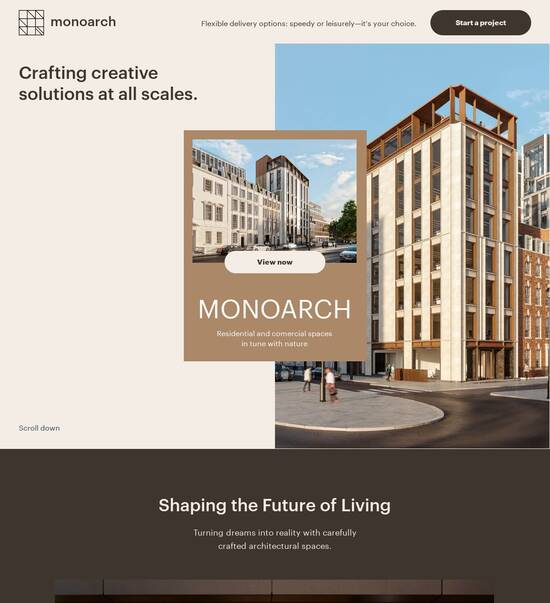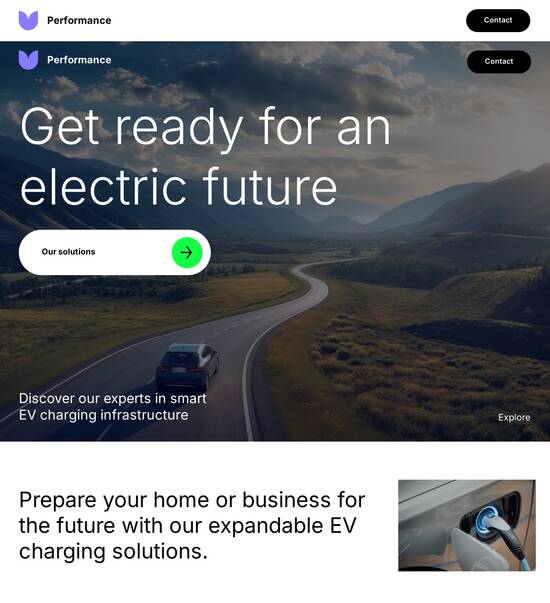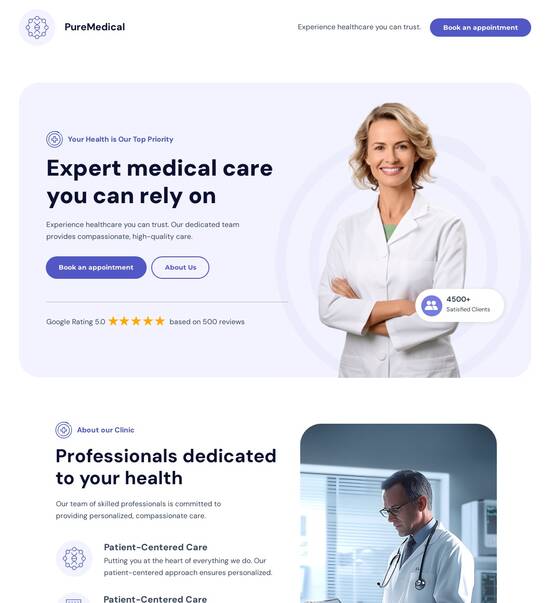
Thank you page template for ASP.NET developers
Explore Similar TemplatesAbout template
Master your online marketing with this builder for thank you page template for ASP.NET developers. Try more tools to create an immaculate landing page.
Recommended templates

Easy to build without coding
With the intuitive drag-and-drop builder, anyone on your team can create high-converting pages without any knowledge of code or design. Make enhancements to your landing page with custom widgets using Javascript, HTML/CSS, or third-party scripts.

Multiple layouts for any industry and goal
Select from 500+ landing page layouts built to boost conversions across industry-specific scenarios. Customize them by adjusting fonts, adding images, and generating on-brand content with the AI assistant. Quickly scale with Instablocks® and Global Blocks that you can save, reuse, and update globally.

Loads fast and looks polished on any device
Every template is responsive, which means they present professionally on any device and load blazingly fast with our Thor Render Engine. You can also power them up with Google AMP technology to deliver an unparalleled mobile experience and drive higher conversions.

Robust analytics & experimentation
Get real-time updates and reporting across all your devices, showing the number of visitors, conversions, cost-per-visitor, and cost-per-lead. Launch AI-powered experiments, run A/B tests, and use heatmaps to analyze user behavior, then optimize your landing page to maximize conversions.







Easy to build without coding
With the intuitive drag-and-drop builder, anyone on your team can create high-converting pages without any knowledge of code or design. Make enhancements to your landing page with custom widgets using Javascript, HTML/CSS, or third-party scripts.
Multiple layouts for any industry and goal
Select from 500+ landing page layouts built to boost conversions across industry-specific scenarios. Customize them by adjusting fonts, adding images, and generating on-brand content with the AI assistant. Quickly scale with Instablocks® and Global Blocks that you can save, reuse, and update globally.
Loads fast and looks polished on any device
Every template is responsive, which means they present professionally on any device and load blazingly fast with our Thor Render Engine.
Robust analytics & experimentation
Get real-time updates and reporting across all your devices, showing the number of visitors, conversions, cost-per-visitor, and cost-per-lead. Launch AI-powered experiments, run A/B tests, and use heatmaps to analyze user behavior, then optimize your landing page to maximize conversions.
All the features you need to build lead-generating landing pages
Explore more featuresLearn how to build top-performing landing pages for any goal
FAQs
Leading the way in building high-performing landing pages





A comprehensive guide to landing pages for marketers on Instapage
In the competitive digital marketing landscape, having a powerful landing page can be the difference between capturing a lead and losing a potential customer. Instapage offers the most effective landing page and conversion rate optimization (CRO) tools, empowering marketers to accelerate their campaigns and maximize ROI. This guide provides a clear, step-by-step approach to building high-converting landing pages tailored to your specific audience.
Understanding the importance of landing pages
Landing pages are crucial for any digital marketing strategy. They serve as dedicated destinations that drive your audience's attention, prompting them to engage with your content or offers. With Instapage, marketers can utilize 100+ templates and various lead generation elements to create eye-catching pages without the need for coding. Here’s how to get started:
- Identify your target audience: Understanding who your potential customers are helps craft content that resonates with them.
- Define your goals: Clear objectives allow you to structure your landing pages to achieve specific outcomes, whether it's collecting emails or direct sales.
- Utilize high-converting templates: Choose from over 100 ready-made templates that facilitate rapid deployment with tailored elements for engagement.
Step 1: Building your landing page with Instapage
Building a landing page on Instapage is user-friendly. Start with selecting a suitable template from Instapage's extensive library. Follow these steps:
- Choose a template that fits your campaign: Each template comes with customizable layouts ensuring branding consistency.
- Let intuitive tools guide you: Use drag-and-drop functionality for seamless edits to elements like texts, images, and forms.
- Preview and adjust: Ensure everything looks perfect before launching by previewing your page on different devices.
Step 2: Optimizing your landing page for conversions
Once your page is built, optimizing for conversions is vital. Instapage provides built-in experimentation features.
- Implement A/B testing: Test multiple versions of your landing page to identify what works best for your audience.
- Use heatmaps: Analyze user behavior to see which areas of your page attract the most attention and adjust accordingly.
- Leverage analytics: Track your page's performance through detailed dashboards and insights to refine future campaigns.
Step 3: Personalizing experiences for better engagement
Personalizing your content can drastically improve engagement rates.
- Dynamic text replacement: Tailor your headlines and content based on the source of your traffic.
- Ad maps: Align specific ads to unique landing pages, creating more contextual relevance.
- Audience-level metrics: Use advanced data tools to monitor how engagement varies across different audience segments.
With these strategies and tools, marketers are equipped to launch high-converting landing pages effectively.
Ready to maximize your campaign's potential? Start using Instapage to enhance your landing pages today.
People also ask about Thank you page template for ASP.NET developers
Thank you page template for ASP.NET developers
Understanding the importance of thank you pages in ASP.NET development
Thank you pages play a crucial role in the journey of an online user. These pages are not just simple confirmations; they serve as a vital touchpoint that enhances user experience. By acknowledging the action a user has taken, such as making a purchase or signing up for a newsletter, thank you pages provide confirmation and a sense of accomplishment for users, which can greatly influence their future interactions with your brand.
In addition to confirming user actions, thank you pages significantly improve engagement metrics. When a user lands on a thank you page, it opens up opportunities for further interaction. This can be through encouraging social sharing, suggesting other relevant content, or providing next steps that align with the users’ interests, thus maintaining their engagement with the site.
Strategies for optimizing thank you pages
To make the most out of thank you pages, ASP.NET developers should consider various strategies. For one, providing options for users to engage further can lead to increased site interaction. Whether it involves linking to social media, offering related products, or inviting users to participate in community forums, these strategies can significantly amplify user interest after the initial conversion.
Analytics is another critical aspect of optimizing thank you pages. By tracking user behavior and conversion rates on these pages, developers can gain insights into what users find engaging or useful. Incorporating metrics such as bounce rates, click-through rates on suggested content, and follow-up conversion rates will shed light on how effective the page is, allowing for continuous improvement.
Key elements of an effective thank you page
An effective thank you page integrates several essential components that enhance its functionality. Personalization is paramount; tailoring the thank you message to different user segments can create a more welcoming and inclusive experience. For instance, recognizing users by name or referencing their specific actions can make them feel valued and encourage ongoing engagement.
Additionally, a clear confirmation message is necessary to validate user actions. Users should leave the page with a sense of assurance that their submission or purchase has been successfully processed. Clearly stating the next steps is equally important; guiding users on what to do after this point helps maintain their momentum of engagement and can lead to further actions, whether that’s browsing more products or joining a mailing list.
Personalization options should be included to tailor messages for different user segments.
Clear confirmation messages must assure users that their actions were successful.
Next steps should guide users on further actions to foster continued engagement.
Visual appeal must be leveraged through design principles to enhance aesthetic effectiveness.
Integrating social proof
Integrating social proof into a thank you page can significantly elevate its impact. Displaying testimonials, user feedback, or even star ratings from previous customers can help reinforce the user's decision. By showcasing positive social interactions, users feel more confident about their choices and are more likely to share their experience.
Furthermore, encouraging participation from the community can engage users more deeply. Whether it’s through integrating a Q&A section or inviting users to share their stories or feedback, this dynamic interaction can promote a sense of belonging and community around your brand, enhancing user loyalty.
Leveraging ASP.NET technologies for dynamic thank you pages
ASP.NET developers can utilize Razor Pages to create dynamic content that makes thank you pages much more interactive and engaging. The Razor syntax allows for seamless integration of backend logic and frontend presentation, making it easy to display personalized messages based on user actions. This capability is essential in delivering a tailored user experience and ensuring that each thank you page speaks directly to the user’s recent engagement.
Additionally, the MVC (Model-View-Controller) framework is instrumental in structuring thank you page responses. By separating the concerns of data management, presentation, and application logic, MVC promotes clarity in code and enhances maintainability. Developers can build scalable thank you pages that are flexible enough to adapt to future requirements as business needs evolve.
Utilizing Razor Pages for seamless content integration can enrich the user experience.
Using the MVC framework allows for better organization of code and maintainability.
Learning to effectively collect and retrieve data enhances personalization efforts.
Data handling techniques
Effective data handling is critical when crafting dynamic ASP.NET thank you pages. Developers can collect user data efficiently through ASP.NET forms while ensuring compliance with data protection regulations. Once collected, this data must be managed properly to allow for personalized experiences on thank you pages. Retrieving and utilizing user data to tailor messages or recommend content keeps users engaged.
Proper data handling also extends to following up with users post-conversion. Using the information gathered during interactions allows developers to create effective follow-up campaigns, whether through email reminders or personalized product suggestions. This practice not only aids in user retention but also enhances overall satisfaction with the brand.
Crafting a thank you page template in ASP.NET
Developing a thank you page template in ASP.NET requires a careful planning process that considers the user journey. Start by mapping out the expected interactions a user may have prior to reaching the thank you page. This insight informs what elements to include, such as specific confirmation messages, recommendations for next steps, and personalization based on prior user actions.
When it comes to coding, attention should be paid to key features like form submissions and data validations. Below are some example code snippets for common functionalities that can enhance the user experience on a thank you page. Incorporating clear structure in the template will not only streamline development but will also create a modular design that can adapt as requirements evolve over time.
Planning the user journey requires understanding the prior interactions users may have had.
Include essential features such as confirmation messages and personalized recommendations.
Code snippets are valuable for implementing functionalities like form submissions.
Incorporating responsive design
In today’s diverse digital landscape, ensuring responsive design for thank you pages is paramount. Users access web content from various devices, hence it’s necessary to adopt responsive design principles that maintain visual integrity across platforms. By utilizing CSS frameworks like Bootstrap or utilizing media queries, developers can create thank you pages that look great on all screen sizes, from smartphones to desktop computers.
Showcasing responsive designs in real-world scenarios can further illustrate the importance of this aspect. For example, a thank you page that adjusts its layout and content presentation based on the device can enhance user satisfaction and lower bounce rates significantly. This approach not only improves user experience but improves key metrics like conversion and engagement rates.
Engaging users beyond the thank you page
Engagement shouldn’t stop at the thank you page; instead, it should act as a springboard for deeper interactions. Encouraging users to share their experiences on social media or through personal networks can significantly widen your brand’s reach. A simple prompt on the thank you page inviting them to share their story or leave a review can foster a community of devoted users who feel appreciated.
Additionally, utilizing thank you pages for enhancing follow-up opportunities is a savvy marketing strategy. Placing prompts for newsletter sign-ups or exclusive offers can maximize retention rates. Presenting users with personalized content or relevant upsells creates a pathway for continued engagement, ensuring that users return, thus cultivating long-term brand loyalty.
Encourage social sharing on thank you pages to extend brand reach.
Utilize follow-up opportunities such as newsletter sign-ups to maintain engagement.
Introduce personalized content to reinforce user interest and loyalty.
Exploring the benefits of a well-designed thank you page
A well-designed thank you page contributes significantly to user retention and loyalty. By leaving users feeling appreciated and validated, businesses can influence long-term engagement. For instance, organizations that effectively utilize thank you pages to acknowledge users' actions often see a more substantial repeat engagement rate, as satisfied users are more likely to return.
Case studies further highlight the importance of well-implemented thank you pages. Brands that focus on personalization and clear communication within their thank you pages tend to report improved customer satisfaction and retention over time. By studying examples of successful implementations, developers can glean insights to elevate their templates.
Analytics and performance tracking
Every CDN-powered ASP.NET developer should incorporate analytics and performance tracking into their thank you pages. Utilizing built-in analytics tools allows developers to monitor how users interact with these pages. Common metrics for success include conversion rates, click-through rates on suggested actions, and overall engagement durations. Setting up tracking effectively provides valuable feedback for future iterations.
Defining key performance metrics also plays a critical role. When developers establish clear goals, such as increasing social shares or prompting further interaction, they can tailor their designs to meet these objectives. Continuous assessment of these metrics will help refine strategies, ensuring that thank you pages remain effective in achieving desired outcomes.
Incorporate analytics to monitor user interactions and feedback.
Define clear performance metrics that guide development efforts.
Continuous assessment helps refine and elevate thank you page effectiveness.
The impact of personalization on user experience
Personalizing thank you pages significantly enhances user experience. Tailoring messages based on the actions users have just completed helps them feel recognized and valued. Techniques like dynamic text replacement, which adjusts content according to specific user demographics or behaviors, can create uniquely impactful interactions.
Succeeding in this approach leads to high conversion rates, as customers feel a deeper connection to the brand. Success stories abound; brands that take advantage of user data to customize thank you pages often report improved conversion metrics and higher levels of customer loyalty.
Community contributions and case studies
Showcasing developer success stories can illuminate practical applications of well-crafted thank you pages. Through interviews and testimonials from ASP.NET developers, insights can be shared about innovative approaches to design and functionality that enhance efficacy. These narratives provide real-world examples that can inspire others to optimize their thank you page designs.
Additionally, engaging with online communities can yield valuable information about troubleshooting common issues. Through forums where developers actively discuss their experiences, common questions about thank you page implementations can surface. Addressing these queries not only aids individuals but can enrich the collective knowledge of the ASP.NET community.
Feature success stories from ASP.NET developers to share innovative solutions.
Engage online communities for troubleshooting and collective learning.
Create a repository of common questions and answers for further assistance.
Future trends in thank you page design for ASP.NET
As technology evolves, so do the trends surrounding thank you page design. One significant trend is the incorporation of artificial intelligence and machine learning, which promise to revolutionize how personalization and user engagement are approached. By analyzing vast amounts of user data, AI algorithms can tailor thank you page content in real-time, enhancing relevance and user satisfaction.
Moreover, evolving user expectations highlight the need for ever-improving experiences. Users increasingly demand not just information but engaging and interactive content. Preparing for this shift involves understanding the capabilities of ASP.NET frameworks that can facilitate richer user experiences. Embracing these trends will ensure that thank you pages remain an integral part of user engagement strategies.
Anticipate the impact of AI and machine learning on personalization capabilities.
Recognize the growing user expectation for interactive and engaging content.
Explore ASP.NET frameworks that can support improved user experiences.
Common pitfalls and troubleshooting strategies
When developing thank you pages, it’s essential to identify and address potential pitfalls proactively. Common mistakes include overly complex designs that confuse users or failing to fully test the functionality. This can lead to user frustration and hinder overall engagement. A straightforward approach often yields a better user experience, as it enhances clarity and usability.
To troubleshoot effectively, developers should engage in frequent testing and utilize analytics to pinpoint areas of concern. Locating issues like slow load times or broken links is key to maintaining user satisfaction. Creating a supportive network among fellow ASP.NET developers can provide insights and solutions, offering a collaborative approach to overcoming challenges.
Identify common mistakes early in the development process.
Engage in frequent testing to catch functional issues before launch.
Leverage community support for effective troubleshooting.
Ready to skyrocket conversions?
Supercharge your ad campaigns with high-performing landing pages
Get started














